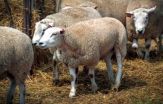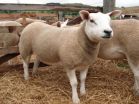What's in the sheep genome? Wool see
2014-06-05
(Press-News.org) After eight years of work, researchers have completed the first sequencing of the entire sheep genome.
Scientists from CSIRO led an international research team to complete the sequencing, which could lead to more effective breeding strategies and new approaches to the management of sheep in Australia and around the world.
With about 70m head of sheep in Australia and 1bn globally, the sequencing of the genome could have a massive impact for the rural economy given that sheep are a major source of meat, milk and wool products.
"We investigated the completed genome to determine which genes are present in a process called gene annotation, which resulted in an advanced understanding of the genes involved in making sheep the unique animals that they are," CSIRO project leader Dr Brian Dalrymple said.
"Given the importance of wool production, we focused on which genes were likely to be involved in producing wool. We identified a new pathway for the metabolism of lipid in sheep skin, which may play a role in both the development of wool and in the efficient production of wool grease (lanolin)."
Publication of the work today in the journal Science is the culmination of the project for the team, which is part of the International Sheep Genomics Consortium, involving 26 institutions across eight countries.
Another key finding from the study involved the rumen, which is a modified stomach full of micro-organisms vital for the digestion of a sheep's diet. The rumen is essential for sheep to convert hard-to-digest plant material into animal protein, and is differentiated from the true stomach by its tough keratin-rich surface, which is very similar to skin.
Many genes normally expressed in skin are also highly expressed in the rumen, but a number of new genes were identified which are rumen-specific, as well as one which appears to be present in most mammals but has so far only been expressed in ruminants.
Sheep are also an important biomedical model, particularly in Australia, and the genomic resources built by the team will provide a strong foundation for the detailed exploration of the similarities and differences between sheep and humans at the molecular level, and hopefully lead to improved medical treatments for a number of conditions such as sepsis and asthma.
INFORMATION:
The Australia components of the project were undertaken at CSIRO, the University of New England, the University of Sydney and a consultancy at Utah State University, and financially supported by: Meat and Livestock Australia and Australian Wool Innovation Ltd and their joint project SheepGenomics, an International Science Linkages grant, the US Department of Agriculture (through collaborations with Utah State University and Baylor College of Medicine) and an Australian Department of Agriculture, Carbon Farming Futures, Filling the Research Gap project.
The collaborating countries and research institutes were: Australia (CSIRO; University of New England; University of Sydney), China (BGI-Shenzhen; Inner Mongolia Agricultural University; Institute of ATCG, Nei Mongol Bio-Information; Kunming Institute of Zoology; Lanzhou Institute of Husbandry and Pharmaceutical Science; Macau University of Science and Technology; North West A&F University; Sichuan Agricultural University), Denmark (University of Copenhagen), France (INRA), New Zealand (AgResearch; University of Otago), Saudi Arabia (King Abdulaziz University), UK (Biosciences KTN; Edinburgh Genomics; European Molecular Biology Laboratory, European Bioinformatics Institute; The Roslin Institute; Wellcome Trust Sanger Institute; University of Edinburgh), USA (Baylor College of Medicine; USDA-ARS Animal Disease Research Unit; Utah State University; Washington State University)
ELSE PRESS RELEASES FROM THIS DATE:
Sleep after learning strengthens connections between brain cells and enhances memory
2014-06-05
June 5, 2014 -- In study published today in Science, researchers at NYU Langone Medical Center show for the first time that sleep after learning encourages the growth of dendritic spines, the tiny protrusions from brain cells that connect to other brain cells and facilitate the passage of information across synapses, the junctions at which brain cells meet. Moreover, the activity of brain cells during deep sleep, or slow-wave sleep, after learning is critical for such growth.
The findings, in mice, provide important physical evidence in support of the hypothesis that ...
Scientists crack sheep genome, shining spotlight on rumen evolution and lipid metabolism
2014-06-05
Shenzhen, June 5, 2014--- The latest study, led by scientists from Kunming Institute of Zoology, Chinese Academy of Sciences, BGI and other institutes, presents a high-quality sheep genome and reveals genomic and transcriptomic events that may be associated with rumen evolution and lipid metabolism that have relevance to both diet and wool. The work was published online today in Science.
Sheep are ruminants with a complex, 4-compartmented "stomach", the largest compartment is the rumen, which is thought to have evolved around 35-40 million years ago, and has the ability ...
Gene study shows how sheep first separated from goats
2014-06-05
Scientists have cracked the genetic code of sheep to reveal how they became a distinct species from goats around four million years ago.
The study is the first to pinpoint the genetic differences that make sheep different from other animals.
The findings could aid the development of DNA testing to speed-up selective breeding programmes, helping farmers to improve their stocks.
The research identifies the genes that give sheep their fleece and uncovers features of their digestive system, which makes them so well-suited to a diet of low quality grass and other plants.
It ...
Brain circuit problem likely sets stage for the 'voices' that are symptom of schizophrenia
2014-06-05
(MEMPHIS, Tenn. – June 5, 2014) St. Jude Children's Research Hospital scientists have identified problems in a connection between brain structures that may predispose individuals to hearing the "voices" that are a common symptom of schizophrenia. The work appears in the June 6 issue of the journal Science.
Researchers linked the problem to a gene deletion. This leads to changes in brain chemistry that reduce the flow of information between two brain structures involved in processing auditory information.
The research marks the first time that a specific circuit in the ...
Research could lead to new cancer assay, aid both dogs and humans
2014-06-05
CORVALLIS, Ore. – Veterinary researchers at Oregon State University have identified a unique group of proteins that indicate the presence of transitional cell carcinoma – the most common cause of bladder cancer – and may lead to a new assay which could better diagnose this disease in both dogs and humans.
Bladder cancer is particularly common in some dog breeds, such as collies, sheepdogs and terriers, but is rarely diagnosed in animals before it has spread significantly. Some assays exist to detect it in humans, but they often have a high-number of false-positive identifications.
An ...
New clues to why older women are more vulnerable to breast cancer
2014-06-05
Scientists from the Department of Energy's Lawrence Berkeley National Laboratory (Berkeley Lab) have gained more insights into why older women are more susceptible to breast cancer. They found that as women age, the cells responsible for maintaining healthy breast tissue stop responding to their immediate surroundings, including mechanical cues that should prompt them to suppress nearby tumors.
Their work sheds light on how aging alters cellular and molecular functions, and how these changes contribute to the prevalence of breast cancer in older women. The disease is ...
MAD: Scientists shed light on braking mechanisms in cellular signaling
2014-06-05
Stanford, CA— A team of researchers studying a flowering plant has zeroed in on the way cells manage external signals about prevailing conditions, a capability that is essential for cells to survive in a fluctuating environment.
Researchers at UC Berkeley, the Plant Gene Expression Center, UC San Francisco, and the Carnegie Institution for Science identified a novel mechanism by which the strength of such an external signal is reduced, or attenuated. Their work focuses on the tiny mustard plant Arabidopsis, which is frequently used by scientists as an experimental model. ...
Exploring a legal and ethical gray area for people with dementia
2014-06-05
(Garrison, NY) Many of the legal and ethical options for refusing unwanted interventions are not available to people with dementia because they lack decision-making capacity. But one way for these people to ensure that they do not live for years with severe dementia is to use an advance directive to instruct caregivers to stop giving them food and water by mouth. This is an ethical and legal gray area explored in commentaries and a case study in the Hastings Center Report.
People with decision-making capacity have the legal right to refuse treatment of any kind and to ...
Can virtual reality therapy help alleviate chronic pain?
2014-06-05
New Rochelle, NY, June 5, 2014—Chronic pain due to disease or injury is common, and even prescription pain medications cannot provide acceptable pain relief for many individuals. Virtual reality as a means of distraction, inducing positive emotions, or creating the perception of "swapping" a limb or bodily area affected by chronic pain in a virtual environment can be a powerful therapeutic tool, as described in several articles in Cyberpsychology, Behavior, and Social Networking, a peer-reviewed journal from Mary Ann Liebert, Inc., publishers. The articles are available ...
Cutting edge methods reveal what makes Purkinje neurons unique
2014-06-05
In a collaboration between RIKEN's Brain Science Institute and Center for Life Science Technologies in Japan, scientists combined cutting edge methods to obtain a comprehensive catalogue of proteins that are manufactured in specific parts of Purkinje neurons.
The study, headed by Drs. Thomas Launey, Unit Leader at RIKEN BSI and Charles Plessy, Unit Leader at RIKEN CLST, succeeded in identifying several thousand RNAs that are enriched in rat Purkinje neurons. This comprehensive list holds the key to a better understanding of molecular events within these neurons and potential ...



